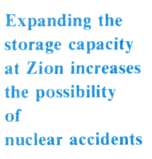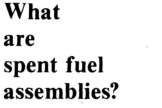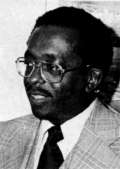

By CATHERINE QUIGG

Spent fuel assemblies from nuclear reactors are accumulating in storage basins at nuclear plants across the nation, including the Zion nuclear station near Waukegan. Because spent fuel contains dangerous, highly radioactive materials which emit radiation harmful for centuries, its buildup is a profound danger to public health. How we resolve the spent fuel situation in Illinois and other states can gravely affect the safety and well-being of future generations.
If the U.S. Nuclear Regulatory Commission (NRC) grants Commonwealth Edison's current request for a further increase in spent fuel storage at Zion, the storage basin there will contain 2,112 spent fuel assemblies or 16 times more fuel assemblies than it was originally intended to store. ComEd intends to increase the storage basin capacity by compaction: the replacement of existing storage racks with new ones designed for much closer spacing of the fuel assemblies. Spent fuel compaction, however, greatly increases the possibilities of disastrous basin accidents. Because of its intense radioactivity, spent fuel gives off substantial heat; therefore, it must be perpetually cooled to avoid overheating and release of the radioactivity into the atmosphere. The fuel's heat is removed by placing the fuel under water and circulating the water. Water also provides radiation shielding. The use of compact racks with their greater fuel load greatly increases the potential for spent fuel overheating in loss-of-water accidents by making air cooling of the fuel extremely difficult. In addition, compact racks increase the risk of criticality — the high power heat generation process that occurs in reactors — which, if it should happen, could overload the cooling system.
The possible consequences ofa serious accident in the pool are mainly the release of strontium-90 and cesium-137 radioactivity into the atmosphere, which would then fall out on the land where it would create a serious cancer risk for hundreds of years. Strontium-90 travels up the food chain and when ingested incorporates into bone tissue where it may cause leukemia and bone cancer. Cesium-137 concentrates in animal muscles and fish; ingested by humans it irradiates the whole body, including bone marrow. The federal government's 1957 reactor hazards study, WASH-740, states that the release of 150,000 curies of strontium-90 could cause agricultural restrictions over 150,000 square miles — the size of Illinois, Indiana, Ohio and half of Pennsylvania combined. At capacity, the Zion basin will have 75 million curies of strontium-90 or 500 times the release quantity assumed in WASH-740.
Past experience, new government research and independent analyses reveal how this radioactivity could be released into the environment. The NRC's Rasmussen reactor safety study, WASH-1400, states that spent fuel can overheat and even melt if water is lost from the storage basin. The repor explains that loss of water could result from dropping a spent fuel cask, for example, causing damage to the basin and rapid drainage; or from a break down in the cooling system, causing boiling off of the basin water. There have already been serious incidents in spent fuel basins. A shipping cask accident at the Morris, 111., storage site in June 1972 resulted in the rupture of the unloading pit basin liner. Water leakage exceeded pump capacity, and by the time the liner was finally sealed, 2,500 gallons of radioactive water had escaped. From Zion, Dresden and other nuclear plants comes word of rack swelling, pump failure, spent fuel drops, basin leaks, overflowing basin water and an accidental criticality during refueling. Although the Zion basin was drained to repair leaks during construction testing, the basin still contains leaks.
There are other serious accident hazards. Commissioner G. Le Fort of l'Energie Atomique of France warned that "a plane could fall on a pool full of very hot fuel elements." In response, R. E. Cunningham of the U.S. NRCs Office of Nuclear Materials Safety and Safeguards said, "We presently are not building pools to withstand a plane crash." It is important to note that the Zion pool lies ne,ar the flight pattern to the Waukegan Airport. A B-52 SAC bomber crashed in Lake Michigan in January 1971 within two miles of the Big Rock Point nuclear plant in Charlevoix, Mich.; the plane was heading directly at the plant. Sabotage is another possibility for destruction of the storage basin.
However, Dr. Richard E. Webb, nuclear engineer and author of The Accident Hazards of Nuclear Plants, contends that the most likely cause of serious on-site spent fuel storage accidents will be an accident which ruptures the reactor containment building. This would force evacuation due to heavy area contamination and thus leave the basin cooling system unattended and subject to loss of water. There have been many near-accidents with nuclear reactors.
In the face of these concerns, there is no adequate report from the government on the consequences of loss of water accidents. The NRC's Rasmussen
Report considers only small amount so noncompact storage — 130 spent fuel assemblies versus 2,112 planned for Zion. Its report assumes only new spread fuel would overheat and melt down and that 99 per cent of the released radio activity would be trapped by the electric powered ventilation-filtration system. This system, however, would be likely to fail in a serious reactor accident. The report does acknowledge that its assumptions are only rough estimates. No detailed thermal analysis was per-formed. The recent NRCs Environ mental Impact Statement for spent fuel storage, NUREG-0404, suggests that pool water can boil but discloses its calculations or details.
Fortunately, an analysis of the loss of water accident is presented in a draft report to the NRC from Sandia Labora tories in Albuquerque, N. Mex., title "Spent Fuel HeatUD Following Loss-o Water During Storage," SAND-77-1371, September 1978. Sandia's calcu lations reveal a new hazard which results from compaction and concert zirconium fuel cladding. The zirconiu can catch on fire upon heatup, which applies not only to newly removed spent fuel but old spent fuel as well. The Sandia report states the fire could become self-sustaining and lead to melting of the fuel cladding.
Unfortunately, the Sandia report stops there and does not investigate the consequences of the self-sustaining fire. But Dr. Webb believes the possibility
exists for such a fire to spread and engulf the entire basin of spent fuel; for the zirconium to melt down, solidify, and plug up air ventilation passages within the spent fuel assemblies, worsening the heatup; for molten zirconium to conceivably lead to a chain reaction of powerful explosions (heated zirconium is highly reactive with air and water); for practically all the strontium and cesium to cook out of the hot fuel rods (the fuel need not melt); and for the basin building to heat up like an oven, pressurize and burst — allowing the radioactive smoke to escape into the atmosphere. Clearly, the public needs a full analysis of the hazards of storing spent fuel in storage basins around the country.
The long-term problems of spent fuel storage at Zion are even more ominous. By storing spent fuel on-site instead of permanently disposing of it deep underground in select geologic rock formations, ComEd and other utilities, with the assistance of the NRC, are struggling to keep the option open to reprocess spent fuel to separate and recover unused fuel, mainly plutonium, which is needed to fuel highly controversial plutonium breeder reactors. However, plutonium is also atomic bomb material and its production increases risks of nuclear weapons j proliferation and terrorism. For this 1 reason, the Carter Administration has 1 blocked reprocessing and is curtailing I breeder development. But by keeping spent fuel at reactor sites — the cheapest and most accessible location — the government and the utilities could pressure the public into eventually accepting both reprocessing and breeder reactors. The financial benefits to the utilities will pale beside the increased risks to the public from the new and greater hazards of spent fuel storage, breeder reactor accidents, increased routine radioactive emissions and plutonium proliferation.
As lor long-term storage, the NRC's Cunningham acknowledges the need for further research into "the question of how long the fuel is to be stored, the long term behavior of the fuel, what we are going to do with the spent fuel after we remove it from the pool, how we are going to remove it from the pool, and how we are going to decommission the pool." This leads to another important consideration — one our Illinois representatives should contemplate. Testifying before the California legislature, NRC Commissioner Victor Gilinsky stated: "A question that ought to be on everyone's mind by now is, what will happen if neither reprocessing nor a [permanent] repository materializes by 1985? The answer must be continued interim storage in pools." Prophetic. A Department of Energy official recently told Congress: "No compelling argument could be found that chemical reprocessing of spent fuel is required for safety in waste management." The official was suggesting instead the ultimate disposal of unreprocessed spent fuel in geologic repositories. However, 11 states have already barred a nuclear waste repository within their borders and 15 more are considering such bans. If every state having possible but unproven geologies for wastes refuses to take them, and if reprocessing is permanently banned, then the radioactive garbage is ours to keep. The on-site spent fuel pools will no longer be considered a potential resource, but expensive and dangerous dumps to monitor and guard for all time.
In its environmental statement the NRC discusses what will happen if there is no reprocessing and if no repositories materialize: "After its spent fuel storage pool is filled, each reactor will have to be placed in a safe shutdown condition, but the operation of the cooling system must be continued to remove decay heat from any spent fuel in the [reactor] core and in the storage pool .... all plant structures will remain, and the exclusion area will have to be maintained. . . . Water use will continue because of the need to disperse the heat produced by the spent fuel." That's how it can happen. We could have a permanent radioactive waste dump in Zion, 111., with perpetual accident and seepage risks — a lake-shore monument for time immemorial to remind us and our posterity of our lack of vigilance in allowing it to happen in the first place. □

The fuel used in most fission-type nuclear reactors is slightly enriched uranium in pellet form. These pellets are cylindrical in shape and are about one half inch in diameter and one half inch high. A fuel rod is formed by stacking these pellets in thin-walled tubes of zircalloy, an alloy of zirconium. Atypical fuel rod contains a 12-foot long column of stacked pellets and is sealed at both ends. Groups of fuel rods, totalling anywhere from 49 to 256 depending upon reactor design, are arranged together to form a fuel assembly. The reactor core consists of 150 to 764 fuel assemblies. These assemblies along with controlling mechanisms and support structures rest inside the reactor vessel.
During operation, some of the uranium atoms fission, or split, and release heat. The atomic pieces left after fission are called fission products. Additionally some uranium will be converted into plutonium, some of which itself will fission. The heat generated in the core is removed by pumping reactor coolant, most often water, through the vessel. This heat is used to produce steam which drives turbine generators to make electricity.
Ultimately, the nuclear fuel in an assembly does not generate enough heat to be economical, so fuel assemblies are replaced with new ones. A fuel assembly remains in a reactor for three to four years. In one year, about one-third of the 90 metric tons of nuclear fuel in a typical reactor is removed and replaced, with fresh fuel. After removal, this spent fuel still produces heat and radiation. The assemblies are handled remotely, generally in water, by special fuel handling equipment. The spent fuel is removed from the reactor vessel and placed in a spent fuel storage pool either within the reactor containment building or in a separate building nearby. A pumping system circulates water around the elements to cool them and to control radiation. After six months of storage, the heat and radiation is reduced so that the assemblies can be shipped offsite.
As of April 1978, about 5,000 tons of commercial spent fuel had been discharged into U.S. storage pools. The U.S. Nuclear Regulatory Commission (NRC) projects a cumulative total of 18,000 tons of spent fuel by 1985, and 95,000 tons by the year 2000. The NRC plans to store 54,000 tons at reactor storage sites, like Zion, and 41,000 tons at sites away from reactors.


By CORDELL REED
On April 16, 1973, the Zion Nuclear Power Plant* was licensed to operate, and it went into commercial operation on December 4, 1973. The capacity of the spent fuel pool was 340 spent fuel assemblies, equal to one and one-third cores. This provided sufficient room to store the one-third core discharged after every refueling until shipment to a reprocessing plant, and one full core in case the reactor had to be fully unloaded for maintenance on the reactor vessel.
Edison had a contract with Allied-General Nuclear Services (AGNS) in Barnwell, S.C., to reprocess the spent fuel. However, AGNS experienced a delay in obtaining a license from the Nuclear Regulatory Commission (NRC) to operate their facilities, and it appeared they would not be in operation in sufficient time to allow continued use of the Zion units with a full core discharge capability. It was originally anticipated that the AGNS facility would be available by 1980.
In October 1975, Edison applied to the NRC for a license amendment to increase Zion's storage capacity to 868 spent fuel assemblies. To accomplish this, we had new racks built that decreased the spacing between fuel assembies. The amendment was approved on August 9, 1976, and the racks were installed during 1976 and 1977. The current storage capacity allows operation of both units until 1981, without loss of full core discharge capability.
On April 7, 1977, President Carter announced that the United States would indefinitely defer reprocessing of spent fuel for recovery of the unfissioned fuel while the United States and other countries evaluate alternative fuel cycles and processes which may reduce risks of nuclear weapons proliferation. However, pending the ultimate decision with regard to the disposition of the spent fuel from United States nuclear reactors, this fuel must be stored, protected and safeguarded.
Hence, it became necessary once more to expand the capacity of Zion's spent fuel storage. On April 13, 1978, Edison applied for a license amendment to increase the capacity to 2,112 spent fuel assemblies. This increase to maximum storage capacity would allow continued operation of both units, without loss of full core discharge capability, through 1991. Currently, 316 assemblies have been placed in the pool, and 128 are discharged annually from the core to the spent fuel pool.
This capacity increase would require a new set of racks in which the spacing between assemblies would be closer. Neutron absorbing material would be built into the racks to guarantee that the spent fuel could be stored with safety. These racks would remain well within the safety limits established by the technical specifications issued by the NRC and applicable codes and standards. At least 10 other facilities across the country have received approval from the NRC to install racks using the same principle.
Upon receiving our application for the license amendment, the NRC printed a notice in the Federal Register, allowing 30 days in which the public could file a petition to intervene in the proceeding. The attorney general of Illinois intervened, representing various environmental groups in the area. A hearing board was named, and a prehearing conference was held at the Lake County Building in Waukegan in November 1978. During the conference the board listened to various concern! expressed by people making limited appearance statements.
The release of large amounts oi radionuclides to the environment from the storage of spent fuel is precluded the design, handling and storage of the fuel assemblies. Once the fuel is stored in the fuel pool, it is in a passive condition, and nothing is done which would cause a rupture of the fuel clad. Even so, cautions are taken to analyze the fuel pool water to indicate whether or not any fuel is leaking through the cladding, If this should occur, the leaking fuel would be removed and placed in special canisters.
Commonwealth Edison continues an extensive environmental monitoring program in the areas around the plant. The program monitors for radiological increases in the milk, soil, grass and air. Base data were accumulated during the construction phase of the plant. To date, no increases of radioactivity have been found. The addition of more spent fuel asemblies stored at Zion will have no discernable effect on the environment. The majority of the radioactive exposure encountered by workers comes from the water in which the spent fuel is stored. Irradiated corrosion products are in the coolant water which is used in part to store the spent fuel assemblies. The actual dose from the assemblies themselves is reduced by the amount of water covering them — almost 20 feet. The radiation levels from the spent fuel assemblies peak about 10 days after shutdown and begin to decrease. Fission products and thermal power of spent fuel aged for two years are less than 1 per cent of that for fresh spent fuel, and activation products are less than 5 per cent. This reduces significantly the need for shielding and cooling for spent fuel assemblies after discharge from the pool. The most radioactive fuel assemblies are the ones just discharged from the reactor.
The draft Report to the President on nuclear waste management, issued by the Interagency Review Group (IRG), proposes that an interim storage facility be available in 1982-1984 and a permanent facility in 1988-1995. The primary objective of waste management planning is "to provide assurance that existing and future nuclear waste from military and civilian activities [including discarded spent fuel from the once-through nuclear power cycle] can be isolated from the biosphere, and poses no significant threat to public health and safety."
Commonwealth Edison feels that the government has lagged in its responsibility for providing an alternate solution for disposition of spent fuel and the disposal of radioactive waste. The technological processes for achieving safe waste handling are already known, so that only political questions remain unaddressed. We believe it is in the public interest for the NRC to reach a prompt resolution of these issues to remove both the fears of the citizenry and the uncertainties plaguing the nuclear industry.□

